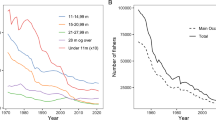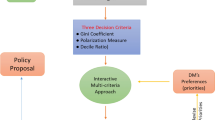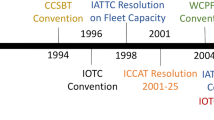Abstract
Sustainability is one of the main focuses of the European Common Fisheries Policy (CFP). Drawing on the definition of Brundtland (Our common future: world commission on environment and development, Oxford University Press, Oxford, 1987) the evaluation of a fishery management regime calls for the investigation of its impact on sustainability of the fishery. An important aspect of that is inter- and intra-generational fairness in the distribution of access rights. Individual Transferable Quota (ITQ) schemes are widely discussed management systems that allow for economic rationalization and are expected to entail increased economic efficiency in the fishery. In order to analyze the impacts of ITQs on sustainability, we focus on three major concerns of inter- and intra-generational fairness connected to ITQs, using the examples of the German and Danish quota systems: the initial allocation of quota shares, changes in the fleet structure, and the implications for newcomers in the fishing industry. In this chapter, we investigate the just use of quota management exemplified by ITQ systems in Germany and Denmark. The methodology of investigating intra- and intergenerational fairness is first explained before this approach is applied to the German and Danish fisheries quota management systems. The last section discusses the results and examines whether ITQs can be classified as a sustainable and thus inter- and intra-generationally just management tool.
Access this chapter
Tax calculation will be finalised at checkout
Purchases are for personal use only
Similar content being viewed by others
Notes
- 1.
In the meantime, however, the number of stocks at risk decreased substantially and also the number of vessels decreased. The main reason for that was the introduction of long-term management plans and not so much the changes in access rights systems (Cardinale et al. 2013).
- 2.
The theoretical framework of justice and its application to the ITQ system is further explained in the paper on ‘Equity and ITQs’ (Doering et al. 2016) In this paper we refer to the instruments of fairness, concentrating on the initial allocation of quota shares, market inrferences, and newcomers to a fishery.
- 3.
- 4.
- 5.
Basically due to a more vulnerable economic position (low profits and low possibilities for renewal of the capital stock, see Lucchetti et al. 2014).
- 6.
- 7.
There are empirical studies about the effect of ITQs on the market structure. Adelaja et al. (1998) investigate the mid-Atlantic surf clam and quahog fisheries for signs of monopoly power after implementation of an ITQ regime. They find a strong reduction in fishing vessels but do not find evidence for monopoly power in the industry. Brandt (2005) showed for the mid-Atlantic clam fishery that small scale fishers were not disproportionately affected by the introduction of ITQs.
- 8.
See Olson (2011) for an overview.
- 9.
- 10.
Many applied ITQ regimes use such measures to address equity concerns and prevent the development of excessive market power of large firms. (See for example Asche et al. 2008).
- 11.
- 12.
Information for this part is also taken from an interview with Marina Lapetina and Sybille Möller (Federal Office for Agriculture and Food, BLE, Department for Fisheries, Hamburg) which took place in January 2012. We would like to thank both experts for the kind support.
- 13.
Generally, this was a fishing vessel that was employed in the fishery by someone in 1986/1987. If such a vessel suffered a total loss, it may be replaced by a ‘smaller’ vessel. Also, a new vessel may be licensed if it replaces one or more licensed vessels.
- 14.
This is true for Baltic cod, North Sea cod, Saithe , plaice and Baltic herring . For Baltic sprat , individual full-time and part-time fishers receive each a total quota.
- 15.
This chapter is based in part on information from Mogens Schou (at that time in the Danish Ministry for Fisheries) given in an interview in January 2012. We thank Mogens for the possibility to talk with him.
- 16.
Personal interview Mogens Schou.
References
Adelaja A, Menzo J, McCay B (1998) Market power, industrial organization and tradeable quotas. Rev Ind Organ 13(5):589–601
Andersen JL (2012) Danish fisheries: management, fleet structure and economic performance. FOI, Copenhagen
Andersen J, Højrup T (2008) The tragedy of enclosure: the battle for maritime resources and life-modes in Europe. Enthnologia Europaea 38(1):29–41
Andersen P, Andersen JL, Frost H (2010) ITQs in Denmark and resource rent gains. Mar Resour Econ 25:11–22
Anonymus (1984) Seefischereigesetz – SeeFischG. BGBl, Bundesministerium der Justiz
Asche F, Eggert H, Gudmundsson E, Hoff A, Pascoe S (2008) Fisher’s behaviour with individual vessel quotas – over-capacity and potential rent: five case studies. Mar Policy 32(6):920–927
Baumgärtner S, Quaas M (2010) What is sustainability economics? Ecol Econ 69:445–450
Becker C (2009) Sustainability ethics and sustainability research. Habilitation thesis, Technical University of Kaiserslautern, Kaiserslautern
Brandt S (2005) The equity debate: distributional impacts of individual transferable quotas. Ocean Coast Manag 48(1):15–30
Brundtland GH (1987) Our common future: world commission on environment and development. Oxford University Press, Oxford
Bundesanstalt für Landwirtschaft und Ernährung (2012) Zweite Bekanntmachung über den Fischfang durch deutsche Fischereibetriebe im Jahr 2012. Amtlicher Bundesanzeiger am 16.05.2012 B6. Bundesministerium der Justiz
Cardinale M, Dörner H, Abella JA, Andersen JL, Casey J, Döring R et al (2013) Rebuilding EU fish stocks and fisheries, a process under way? Mar Policy 39:43–52
Casey KE, Dewees CM, Turris BR, Wilen JE (1995) The effects of individual vessel quotas in the British Columbia halibut fishery. Mar Resour Econ 10(3):211–230
Chu C (2008) Thirty years later: the global growth of ITQs and their influence on stock status in marine fisheries. Fish Fish 10:217–230
Copes P (1986) A critical review of the individual quota as a device in fisheries management. Land Econ 62(3):278–291
Copes P, Charles A (2004) Socioeconomics of individual transferable quotas and community-based fishery management. Agric Resour Econ Rev 33(2):171–181
Data Collection Framework (DCF) Database 2012
Doering R, Goti L, Fricke L, Jantzen K, Equity & ITQs (2016) About fair distribution in quota management systems in fisheries. Environ Values 25(6):729–749
European Council (1983) Council Regulation (EEC) No 170/83 of 25 January 1983 establishing a community system for the conservation and management of fishery resources. Off J Eur Union
European Council (2013) Regulation (EU) No 1380/2013 of the European Parliament and of the Council of 11 December 2013 on the Common Fisheries Policy, amending Council Regulations (EC) No 1954/2003 and (EC) No 1224/2009 and repealing Council Regulations (EC) No 2371/2002 and (EC) No 639/2004 and Council Decision 2004/585/EC. Off J Eur Union L354
Geen G, Nayar M (1989) Individual transferable quotas in the southern blue/in tuna fishery: an economic appraisal. In: Neher PA, Aranson R, Mollet N (eds) Rights based fishing. Kluwer Academic Publishers, Dodrecht/Boston/London, pp 355–381
Grafton RQ (1996) Individual transferable quotas: theory and practice. Rev Fish Biol Fish 6(1):5–20
Hatcher A, Pascoe S, Banks R, Arnason R (2002) Future options for UK fish quota management. A report to the Department for the Environment, Food and Rural Affairs. CEMARE report 58, Portsmouth
Hilborn R, Parrish JK, Little K (2005) Fishing rights and fishing wrongs. Rev Fish Biol Fish 15:191–199
Host J (2015) Market-based fisheries management: private fish and captains of finance. Springer, Heidelberg
Lucchetti A, Piccinetti C, Meconi U, Frittelloni C, Marchesan M, Palladino S, Virgili M (2014) Transferable fishing concessions (TFC): a pilot study on the applicability in the Mediterranean Sea. Mar Policy 44:438–447
Mace PM, Sullivan KJ, Cryer M (2014) The evolution of New Zealand’s fisheries science and management systems under ITQs. ICES J Mar Sci 71:204–215
Matthiasson T (1992) Principles for distribution of rent from a ‘commons’. Mar Policy 16(3):210–231
Morin M (1999) The legal status of marine resources and the concept of ownership. In: Symes D (ed) Alternative management systems for fisheries. Fishing News Books, Oxford, pp 173–178
National Research Council (1999) Sharing the fish: toward a national policy on individual fishing quotas. The National Academies Press, Washington, DC
Nøstbakken L (2006) Cost structure and capacity in the Norwegian pelagic fisheries. Appl Econ 38(16):1877–1887
Olson J (2011) Understanding and contextualizing social impacts from the privatization of fisheries: an overview. Ocean Coast Manag 54:353–363
Pinkerton E, Edwards DN (2009) The elephant in the room: the hidden costs of leasing out individual transferable fishing quotas. Mar Policy 33:707–713
Sandberg P (2006) Variable unit costs in an output-regulated industry: the fishery. Appl Econ 38(9):1007–1018
Shotton R (2001) Case studies on the allocation of transferable quota rights in fisheries. FAO fisheries technical paper 411
STECF (2014) The 2014 annual economic report on the EU fishing fleet (STECF 14–16) – statistical database. Publication office of the European Union, Luxembourg
Sumaila UR (2010) A cautionary note on individual transferable quotas. Ecol Soc 15:36
Townsend R, Shotton R, Uchida H (eds) (2008) Case-studies in fisheries self governance. FAO fisheries technical paper. No. 504
Wang SDH (1995) The surf clam ITQ management: an evaluation. Mar Resour Econ 10(2):93–98
Acknowledgments
We are grateful to the German Federal Ministry of Education and Research (BMBF) for financial support under grant No. 01UN0607. Lorena Fricke was additionally funded by the European Union’s Seventh Framework Programme research project PREFACE (Grant agreement 603521) and Leyre Goti by the European Union’s Seventh Framework Programme research project SOCIOEC (Grant agreement 289192). Parts of the study are conducted with the help of interviews with experts from the field of fisheries management in the respective countries. The authors would like to thank Marina Lapetina and Sibylle Möller (Federal Office for Agriculture and Food (BLE), Department for Fisheries, Hamburg), and Mogens Schou (at that time in the Danish Ministry for Fisheries).
Author information
Authors and Affiliations
Corresponding author
Editor information
Editors and Affiliations
Rights and permissions
Copyright information
© 2018 Springer International Publishing AG
About this chapter
Cite this chapter
Jantzen, K., Döring, R., Goti, L., Fricke, L. (2018). Individual Vessel Quotas in Germany and Denmark: A Fair Distribution Process?. In: Winder, G. (eds) Fisheries, Quota Management and Quota Transfer. MARE Publication Series, vol 15. Springer, Cham. https://doi.org/10.1007/978-3-319-59169-8_8
Download citation
DOI: https://doi.org/10.1007/978-3-319-59169-8_8
Published:
Publisher Name: Springer, Cham
Print ISBN: 978-3-319-59167-4
Online ISBN: 978-3-319-59169-8
eBook Packages: Earth and Environmental ScienceEarth and Environmental Science (R0)




